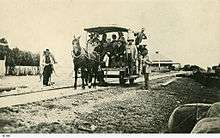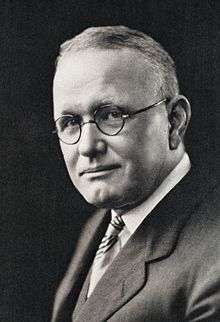South Australian Railways
 | |
| Industry | Railway operator |
|---|---|
| Successor | Australian National |
| Founded | 1854 |
| Defunct | 28 February 1978 |
| Headquarters | Adelaide |
Area served | South Australia |
| Parent | Government of South Australia |
South Australian Railways was the statutory corporation through which the Government of South Australia built and operated railways in South Australia from 1854 until March 1978, when its non-urban railways were incorporated into the Australian National, and its Adelaide urban lines were transferred to the State Transport Authority.
South Australia is one of the few places in Australia, if not the world that has all three major rail gauges, in addition to other uncommon gauges.
History


The first railway in South Australia was laid in 1854 between Goolwa and Port Elliot to allow for goods to be transferred between paddle steamers on the Murray River and seagoing vessels. The next railway was laid from the harbour at Port Adelaide to the colony, and was laid with Irish gauge 5 ft 3 in (1,600 mm) track. This line was opened in 1856. Later on, branch lines in the state's north in the mining towns of Kapunda and Burra were linked through to the Adelaide metropolitan system. From here, a south main line extended to meet the horse tramway from Victor Harbor to Strathalbyn, and towards the South Australia/Victoria Border.
With the metropolitan systems being broad gauge, the mid north and south east of the state were originally laid with 3 ft 6 in (1,067 mm) narrow gauge track. These systems were closely based on British practice, as was the broad gauge system prior to 1926. Locomotives and rolling stock were bought from the United Kingdom and United States, from builders such as Beyer, Peacock and Company, Dübs and Company, their successors, the North British Locomotive Company, and Baldwin Locomotive Works. Nine broad gauge tank locomotives plus the frame of a tenth were bought second-hand from the Canterbury Provincial Railways in New Zealand when it converted to narrow gauge.

In 1922, after the SAR's worst financial deficit, the government appointed American railroad manager William Webb, from the Missouri-Kansas-Texas Railroad as Chief Commissioner. When Webb arrived in Adelaide with his young family, he found a railway system unchanged since the late 19th century. The locomotives and rolling stock were small, wagons and carriages were of wooden construction, the track and bridges were unsuitable for heavy loads, the workshops had antiquated machinery and the signalling system was inflexible. These attributes drove up the ratio of operating costs to revenue.
Webb introduced a rehabilitation plan based on American railroad principles of large, standardised locomotives and steel bodied freight wagons, with automatic couplers to enable a significant increase in productivity. Lightly patronised passenger trains would be replaced by self-propelled rail cars, enabling faster, more frequent and more efficient services. He recruited Fred Shea as his Chief Mechanical Engineer and had him prepare specifications for this new equipment. This resulted in orders being placed for 1,200 wagons of four types from American Car and Foundry, 12 petrol mechanical railmotor cars from the Service Motors Corporation, Wabash, Indiana, and 30 locomotives based on American Locomotive Company plans but built by Armstrong Whitworth & Co in the United Kingdom. These were of the Mountain, Pacific and Mikado wheel arrangements, 10 of each type, which became the 500, 600, and 700 class locomotives.[1][2]
To carry the heavier trains, the rehabilitation plan included the strengthening of track and bridges, and the conversion of the mid north narrow gauge system (the Western division) to broad gauge. The antiquated Islington Railway Workshops were demolished and replaced with a thoroughly modern railway maintenance and manufacturing works, a large new round house was built at Mile End, near Adelaide, and several 85 foot turntables were installed throughout the state to enable the much larger locomotives to be turned. Efficient train operations were facilitated by the adoption of American train order working on country lines, and Adelaide railway station was replaced with an imposing new building, opened in 1927.[1] This grand building has been partially taken over by the Adelaide Casino.

When the two shiploads of new locomotives arrived in 1926 they caused a sensation with the public and throughout the railway industry in Australia. The 500 class "Mountain" was over twice the size of the biggest pre-Webb engine, and was the most powerful locomotive in Australia. Henceforth double heading broad gauge trains became a rarity in South Australia. The massive locomotives were unloaded at Port Adelaide and taken off the pier by horses (the locomotives weight alone exceeding the docks maximum loading capacity). Apart from some initial teething problems (mainly to do with overheating bearings and rough riding due to excessive play allowed on driving axles) the new locomotives settled in nicely to their assigned positions. After the success of the original locomotives, ten more 700 class locomotives, with larger tenders, were locally built using the facilities of the new Islington Workshops. These were the 710 class.[1]
The 500 class was rated to haul 400 tons over the Mount Lofty Ranges immediately east of Adelaide, where a 19-mile (31 km) continuous 1-in-45 (2.2%) gradient faced trains heading for Victoria. Two years after their introduction, the class was modified by the addition of a booster engine which required replacement of the rear two wheel truck with a four-wheel truck. This altered the wheel arrangement from 4-8-2 to 4-8-4, however the term Mountains stuck with the locomotives. Reclassified 500B class, their maximum load to Mount Lofty was increased to 600 tons, or eleven passenger cars. In the pre-Webb era the Rx class - a 4-6-0 with a Belpaire firebox was rated at 190 tons for this line, with three of them required to lift a heavy Melbourne Express - two at the front and one banking from the rear.[3]
The broad gauge system was the main focus of Webb rehabilitation scheme. The narrow gauge systems north of Terowie and on the Eyre Peninsula remained untouched, as did the South Eastern division (although it was subsequently converted to broad gauge in the early 1950s).
Webb decided not to extend his contract in 1930 and returned to the US, having revolutionised the SAR.
In 1936 for the centenary year of the state, a fleet of ten new 620 class Pacific type locomotives were introduced. These locomotives, with streamlining based on that of the London & North East Railway's P2 class Cock O' the North locomotive, were able to traverse branch lines laid with 60-pound rail, as well as the mainline 80-pound rail, and were used to power the East-West Express between Adelaide and Port Pirie from 1937, after the extension of the broad gauge line north from Red Hill. Concurrently, the Commonwealth Railways extended their standard gauge Trans-Australian Railway line south from Port Augusta, and a new transfer station was opened at Port Pirie Junction.[4]
Other additions to the big power locomotive fleet after the Depression included the 720 class, Berkshires based around the 700 and 710 class locomotives, the 740 class based around the 700 class, and the 520, a modern light lines locomotive, styled after the Pennsylvania Railroad T1, and more than able to handle all mainline passenger services except the heaviest services over the Mount Lofty Ranges.
In June 1949, the first 350 class diesel locomotives entered service.[5] The first main line diesel locomotives to enter service were the 900 class in 1951. Both of these classes were built by Islington Railway Workshops. The SAR then turned to American Locomotive Company products with the 930, 830, 600 and 700 classes manufactured in Sydney by AE Goodwin. In the 1950s, railcars were introduced, the Redhens for Adelaide suburban services and the Bluebirds for regional services.
As part of the Sydney-Perth standard gauge link, the Port Pirie-Broken Hill railway line was converted to standard gauge while the Roseworthy-Peterborough line north of Terowie was converted from narrow to broad gauge in 1970.
In the 1972 election, the Whitlam Federal Government made a commitment to invite the states to hand over their railway systems to the federal government. The Government of South Australia took up the offer, but elected to retain the Adelaide metropolitan services that were transferred to the State Transport Authority. Financial responsibility for the remaining services passed to the Federal Government on 1 July 1975, although the SAR continued to operate services until operations were formally transferred on 1 March 1978 to Australian National.[6]
Steam Locomotives
Broad Gauge
- 1-3
- 154
- 155
- 205
- 500 class
- 520 class
- 600 class
- 620 class
- 700 class
- 710 class
- 720 class
- 740 class
- 750 class
- A class
- B class
- C class
- D class
- E class
- F class (first)
- F class (second)
- G class
- Ga class
- Gb class
- Gc class
- Gd class
- Ge class
- H class
- I class (first)
- I class (second)
- J class
- K class
- Kitson Goods Motors class
- M class (first)
- M class (second)
- N class
- O class (first)
- O class (second)
- P class
- Q class
- R/Rx class
- S class
Narrow Gauge
- 0
- 107
- 260
- 300 class
- 400 class
- K class
- T class
- U class
- V class
- W/Wx class
- X class
- Y/Yx class
- Z class
Diesel Locomotives & Railcars
Commissioners
- William Alfred Webb 1923-1930
- William James Cleary
See also
References
- 1 2 3 R.I.Jennings. (1973). W.A.Webb: South Australian Railways Commissioner 1922-30. Adelaide. pp. 71, 85, 102–134.
- ↑ David Burke. Kings of the Iron Horse. Methuen. 1985. p118-121.
- ↑ Douglas Colquhoun et al. 500: The 4-8-2 and 4-8-4 Locomotives of the South Australian Railways. Australian Railways Historical Society. 1969. pp. 4, 11, 15-16
- ↑ Burke, Ibid
- ↑ Broad Gauge 350-class diesel locomotives Chris' Commonwealth Railways Pages
- ↑ Australian National Railways Amendment Act 1978 Government of Australia